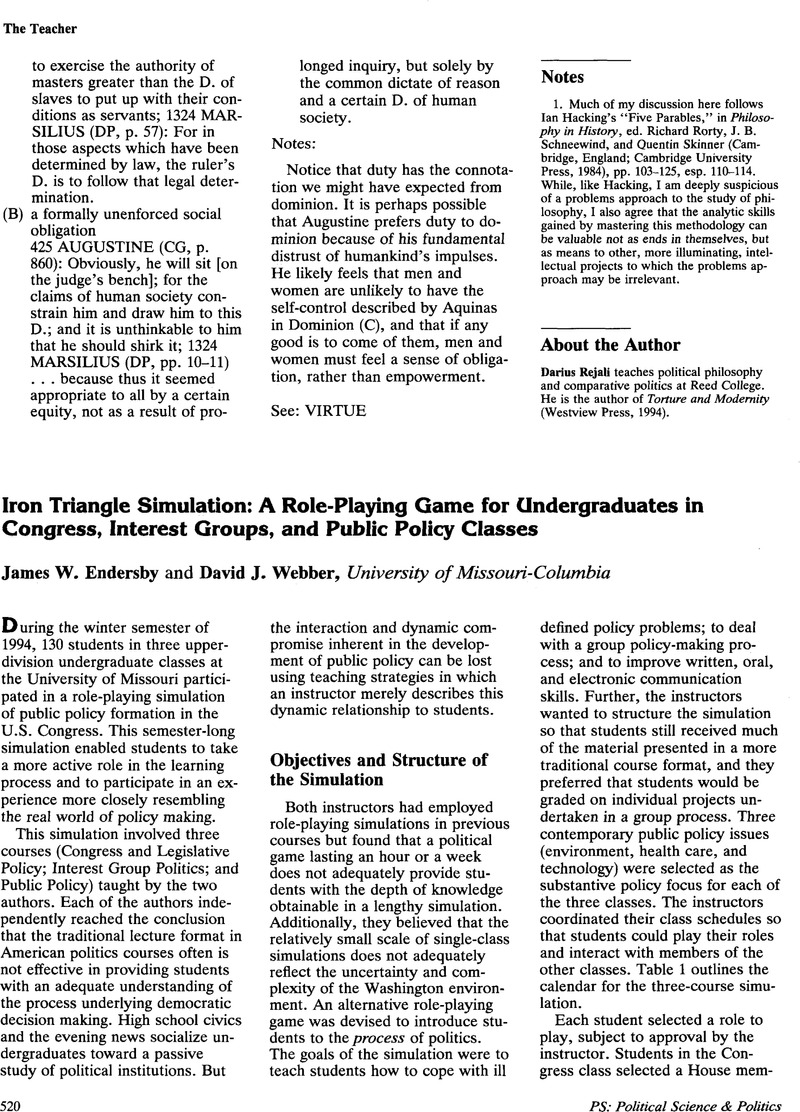Article contents
Iron Triangle Simulation: A Role-Playing Game for Undergraduates in Congress, Interest Groups, and Public Policy Classes
Published online by Cambridge University Press: 02 September 2013
Abstract

- Type
- News
- Information
- Copyright
- Copyright © The American Political Science Association 1995
References
Notes
The authors express their gratitude for assistance, support, and resources provided by the University of Missouri Alumni Association, the College of Arts and Science, the Department of Political Science, and Donna Hanly.
1. Care must be taken in the selection of the roles because students tend to uncharacteristically choose public interest organizations over more traditional lobbies. Competing interests (the NRA and Handgun Control, prolife and prochoice lobbies) significantly add to realism.
2. Once the simulation began, the instructors were reluctant to interfere in the decision making process and restrict activity to the three policy areas. After preparation of research papers, however, most students naturally stayed within these confines and offered few bills or amendments outside the areas of environment, health, and technology.
3. Some students were initially impressed by the large number of people attending the introductory meeting. Seeing nearly a hundred other students from other classes seemed to instill feelings that this class project was important.
4. The paper, Simulation Weekly, had four editions and a post-simulation “extra” listing final outcomes of proposed legislation.
5. About 40–50% of a student's course grade depended on simulation-related activity. In the Interest Groups class, for instance, 20% of a student's grade came from the research paper (which served as the basis for that student's role), 20% from simulation participation (activities outside the classroom), and 10% from class participation (a portion of which dealt with the simulation).
6. The absence of fiscal constraints, for example, led the instructors to insist on funding limitations. Each bill had to fund itself (through specific budget cuts and so forth). But even this was done indirectly. The OMB and the White House issued electronic press releases, and a simulated President Clinton was quoted in Simulation Weekly as saying that he would veto any House legislation that raised taxes or the deficit.
7. One student did initially object to opening daily House sessions with a prayer but was satisfied when assured that this is a regular practice. The instructors were puzzled by the Representatives' refusal to leave their seats on the floor of the chamber even during one-minute speeches and legislative debate on predetermined votes. This curious phenomenon severely restricted lobbyists and staffers from contact with members of Congress as they were not allowed on the floor. On the other hand, members voluntarily met congressional norms. For instance, former President Richard Nixon died on the weekend of our simulation. Republicans wore black corsages after the announcement, and the House held a moment of silence during the Saturday session.
8. Four of these bills passed the Senate. A few bills were defeated in the House or failed to reach a floor vote. Most legislation, however, died in committee.
- 34
- Cited by




